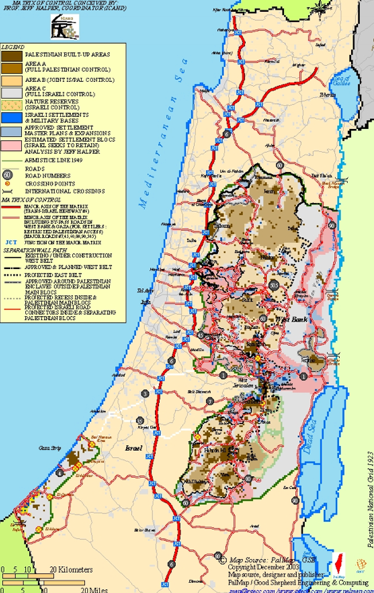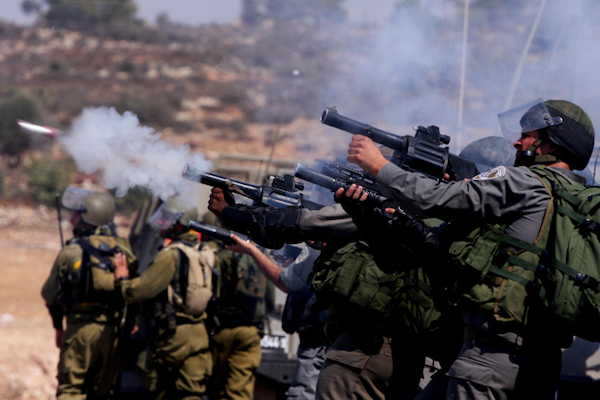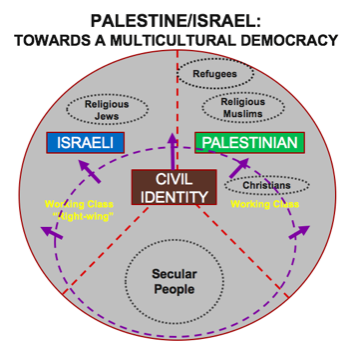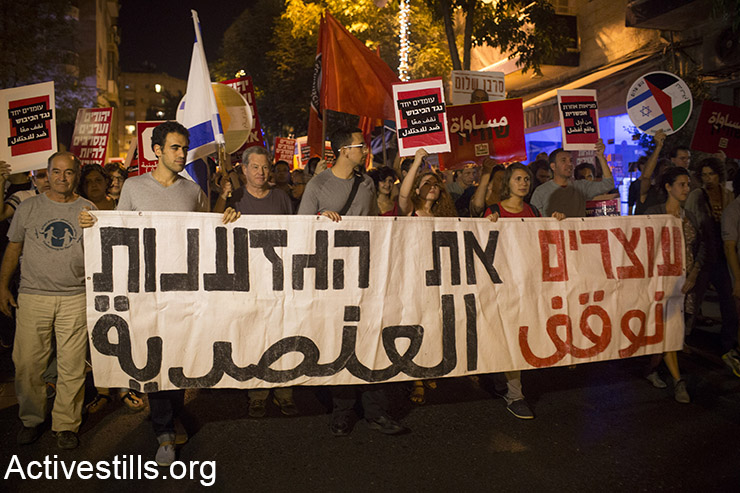Progressive Israelis and Palestinians have a crucial task: mounting a political movement that gives us an effective voice in forging the future of our country.
By Jeff Halper

As we reach the 50th “anniversary” of Israel’s occupation, it is hard to discern on the horizon either a workable political program or a focused political movement beyond the vague slogan: End the Occupation. The “solution” espoused by the Israeli peace movement for the past 50 years and by the PLO/PA for the past 30 years — two states for two peoples — has become as ritualized and fossilized as it is defunct. It has been buried deep under Israeli “settlements,” as we continue to call massive urban blocs in East Jerusalem and the West Bank housing some 800,000 Israeli residents.
Consciously, systematically and with unlimited resources, Israel has virtually completed Zionism’s great project: effectively “Judaizing” the country, transforming Palestine into the Land of Israel. “East” Jerusalem, annexed in 1967, has long since ceased to exist as a coherent, functioning urban entity. The West Bank has become Judea and Samaria. More than 90 percent of the entire country’s Palestinians have been confined to just 12 percent of the land, even though they represent close to half the population. Greater Israel is a reality, an irreversible reality, undeniably a single apartheid state. Just a glance at a map showing the “matrix of control” Israel has permanently laid over the occupied Palestinian territories (OPT) shows that reality.
The map shows just how every Israeli government deliberately eliminated any possibility of a viable Palestinian state over the past five decades. Areas A and B (in brown) show to what degree Palestinian territory has been fragmented into tiny enclaves divided from one another by Israeli settlement “blocs” (in pink), the Separation Barrier and a maze of Israeli highways.

Israel controls all the OPT’s vital resources, plus its airspace and communications sphere. Using walls and a permit regime, it has detached “Greater Jerusalem” from Palestinian society and economy, thus robbing the Palestinians of their political, religious and cultural center as well as their major tourist attraction, the source of 40 percent of their economy.
The map can’t show the rest: the destruction of the Palestinian economy and the impoverishment of its people (70 percent or more living under the poverty line); displacement (almost 50,000 Palestinian homes demolished in the OPT since 1967, on the backdrop of more than 70,000 within Israel since 1948); a traumatized population that has endured decades of unrelenting and repressive military occupation, 800,000 of whom have been imprisoned at one time or another, many tortured; restrictions on movement and even family unification; induced emigration; and more.
Let’s admit it. No Israeli government over the past 50 years has seriously entertained the prospect of a genuinely coherent, sovereign and viable Palestinian state, even during the brightest days of the Oslo “peace process.” What exists today is apartheid. A single state — Israel — rules the entire country and over an entire people without civil, human or national rights.
One effective government, one army, one economy, one infrastructure and territorial/settlement contiguity dominates Palestinian life politically, economically, militarily and physically, while the Palestinian population, half of that of the entire country, is confined to dozens of tiny enclaves on only 10 percent of the land. Whatever “deal” the Trump Administration reaches will only be a variant of this apartheid regime.

(Issam Rimawi/Flash 90)
Over the years progressive Israelis have toyed with various and sundry solutions, invariably variations on the two-state theme. Most are “federalist” schemes of one kind or another, resurrecting Lova Eliav’s notion of a state in which nationality is separated from territory. A proposed “Holy Land Union” envisions three states for two peoples in one land, “a secular Federal State which has sovereignty over the territory and over two non-territorial nation-states.”
Another “Israel-Palestinian Federation” offers 15 federal districts divided along Jewish-Arab population lines. “Two States/One Homeland” is even more convoluted. Here the two national groups share the same homeland but retain separate citizenships, political systems and parliaments, wherein “both states would agree on a proportional number of citizens of the other state who would live in their territory and would receive the status of permanent residents.”
What unites all these versions of the two-state solution is a rock-solid conviction that Palestinians and Israelis are so incompatible they cannot share the same polity — a notion I for one do not accept. Invariably they leave security in Israeli hands for the foreseeable future, rendering them non-starters for Palestinians.
From apartheid into a multicultural democracy
The deliberate and systematic elimination of the two-state solution by Israel and the inadmissibility of apartheid leave only one option for a just political settlement to a conflict as destabilizing to the entire region as it is destructive to the Palestinians themselves: a single democratic state that ensure equal civil rights to all its inhabitants. One person, one vote. A single parliamentary regime, the creation of a robust and inclusive civil society, the full integration of the army and security forces, return of all the Palestinian refugees who choose it (accompanied by land redistribution, financial compensation, housing and affirmative-action education and hiring), and an economy that serves everyone.
As in many other countries, Palestine/Israel is also multicultural. As depicted in the attached model, it consists of national groups (Palestinian Arabs and Israeli Jews); religious communities (Muslims, Jews and Christians in a myriad of denominations, some, as in the case of Hamas, the more secular Fatah or religious Zionists, related to political communities as well); and ethnic groups (Mizrahi Jews, Druze, the asylum-seeker community and others, often connected by class standing and geography as well). Many of these groups are fluid, potentially cross-cutting, but nevertheless as meaningful as individual identities.

While everyone would participate in the wider civil society, citizens could also choose to retain their various identities, even remain within their communities. Certainly in a society that has known a century of civil and national wars, settler colonialism and occupation, collective identities will remain central both as frames of reference and as sources of security. People would be free to gravitate to whatever “sector” they wanted — though, again, fluidity among sectors and identities is possible.
More religious Jews and Muslims, for example, might gravitate more to their own national/religious communities. So, too, would the returning refugees of the first generation, plus older people and perhaps also the working-classes. Indeed, this multiculturalism will be acknowledged by the state and embodied in the Constitution, which will guarantee collective as well as individual rights, the rights to language, heritage and communal institutions alongside those of civil society.
Constitutionally-protected multiculturalism will prevent the Knesset from passing any laws that harm the integrity of any national, religious or cultural group or that privilege one community over the others (except in the realm of affirmative action). This would provide an additional layer of protection for Israeli Jews, whose collective identity, language and heritage would be acknowledged, as would that of the Palestinians.
As the years pass and both citizens and communities feel a sense of security, trust and inter-connectivity, however, and as younger generations emerge for whom life in a common civil society is normal, a common civil identity will emerge and expand. Attracting at first primarily the younger generation, more secular people and the middle classes, an inclusive civil society would grow as a common life becomes routinized through common citizenship, a common parliament, common collective experiences arising out of the daily dynamics of life, civil marriage, integrated communities and schools, common media, the learning of one another’s language, common invented holidays and symbols, etc. Not merely a new political entity but a new society would arise, an example to others of how ethnic conflicts can be resolved through equality, democracy and multiculturalism.
Political actors or gadflies?
Besides formulating just, workable solutions, progressive Israelis and their Palestinian partners have yet another crucial task: mounting a political movement both inside the country and internationally, at the grassroots as well as in parliaments, that gives us an effective voice in forging the future of our country. We must decide if we want to be political actors or merely commentators. If the former, four things are necessary in my view:
1. We must formulate a just and workable political program — in my view along the lines I presented above. We must do it since no one else will, not governments, not political parties, not NGOs, not academic forums, not activists whose resistance on the ground, important as it is, is not directed towards an actual political program. Indeed, we are the only actors who combine (1) critical political analysis with (2) “on the ground” experience and (3) the ability to mobilize civil society at home and abroad — all needed for achieving a just and workable political settlement. Armed with a political plan, even a few people have the power to galvanize our disparate forces into a powerful and focused movement. That’s what our adversaries, the settlers of 50 years ago, did. The Right the world over sees itself as an actor and has worked hard to emerge out of ridicule and obscurity to a position of dominance today. The Left, which once had the political momentum, seems to have lost faith in its ability to lead. We have marginalized ourselves. Its time to get back into the game, in Palestine/Israel as elsewhere.

2. The Palestinians, for all their constraints, must take the lead. There’s simply no other way, no one else can represent the Palestinian cause or has the right to formulate a political program. Without their guidance, direction and leadership we are stuck, nothing can happen. The worldwide BDS movement has succeeded in mobilizing masses in support of Palestine. It leaves them hanging, however. The masses of supporters for a just peace in Palestine/Israel can be and have been mobilized, but they have to know to what end. What are we demanding of our political leaders? “End the Occupation” is a beginning, but end it for what? The many Israelis and internationals mobilized to support Palestine must be empowered and led by Palestinians.
3. We must understand the urgency of the moment on two levels. First, politically: Trump, Netanyahu, Abu Mazan and the rest are cooking up a regime of permanent, internationally-sanctioned apartheid, and it’s happening now. Where are we? What are we offering as an alternative? Ha’aretz recently (May 24th) described the U.S. administration as “looking for common principles” towards a settlement. We can offer five:
• A just peace must find a balance between collective rights (self-determination) and individual rights (democracy);
• A just peace and the negotiations leading up to it must conform to human rights, international law and UN resolutions;
• A just peace requires that the refugee issue be fully resolved;
• A just peace means establishing a political system and civil society that ensures social, economic, political and cultural equality, and complete integration of the security forces;
• A just peace must be regional in scope.
Why aren’t we throwing our principles into the discussion? If we don’t organize immediately and effectively, which means first and foremost formulating a political plan of our own, we will simply lose. We do not have all the time in the world. One can argue, as many Israelis and even Palestinians do, that “now is not the time” for a solution; let’s leave it to the next generation.
Israeli apartheid might indeed fall someday, but is it a political plan to wait, merely protest and place our hopes in future generations? Nor we can take a mystical approach. Just as South African apartheid fell, we often hear, so it will in Israel. The fallacy of course, is that it did not “fall” merely by the weight of its own injustice. It was defeated by the hard work of the ANC.
Providing political direction is urgent for internal movement reasons as well. People are starting to drift away from the Palestinian cause. Political struggle abhors a vacuum. Without an endgame to advocate for, people will begin to leave. If nothing moves for years on the Palestinian front (except ever-greater occupation), people shift their time and energy to more immediate issues: Syrian and other refugees, battling Trump and Theresa May, climate change, identity politics, local issues, etc. We must build a movement — or, rather, galvanize the movement that exists but is stuck and without direction. Formulating a joint political program is of utmost urgency.
We should be marking 50 years of occupation, but resolving to ourselves that this will be the first year of effective resistance, advocacy and political movement. The window is closing.
Jeff Halper is the Director of the Israeli Committee Against House Demolitions (ICAHD) and a founder of ‘The People Yes! Network,’ dedicated to building an infrastructure for the Left. He can be reached at: jeffhalper@gmail.com.

